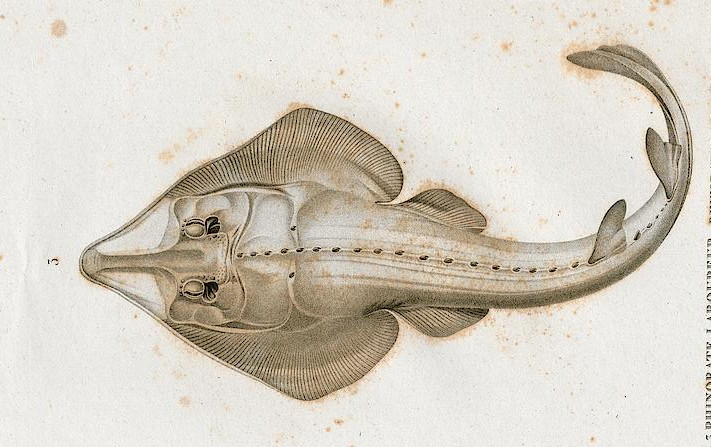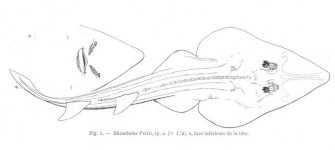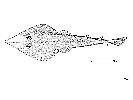Glaucostegus cemiculus
(Geoffroy Saint-Hilaire, 1817)
Blackchin guitarfish
Classification: Elasmobranchii Rhinopristiformes Glaucostegidae
Reference of the original description
Poissons du Nil, de la Mer Rouge et de la Méditerranée, In Description de l'Egypte ou recueil des observations et des recherches qui ont été faites en Égypte pendant l'expedition de l'Armée français, publié par les ordres de sa Majesté–L'Empereur Napoléon le Grand., pl. 18–27.
Poissons du Nil, de la Mer Rouge et de la Méditerranée, In Description de l'Egypte ou recueil des observations et des recherches qui ont été faites en Égypte pendant l'expedition de l'Armée français, publié par les ordres de sa Majesté–L'Empereur Napoléon le Grand., pl. 18–27.
Image of the original description

Glaucostegus cemiculus (Geoffroy Saint-Hilaire, 1817) Plate 27 Fig. 3

Glaucostegus cemiculus (Geoffroy Saint-Hilaire, 1817) Plate 27 Fig. 3
Synonyms / new combinations and misspellings
Glaucostegus petiti, Rhinobatos cemiculus, Rhinobatos cemiculus rasus, Rhinobatos congolensis, Rhinobatos petiti, Rhinobatos rasus, Rhinobatos (Glaucostegus) cemiculus, Rhinobatos (Glaucostegus) petiti, Rhinobatus cemiculus, Rhinobatus congolensis, Rhinobatus petiti, Rhinobatus rasus, Rhinobatus (Rhinobatus) cemiculus, Rhinobatus (Rhinobatus) petiti
Glaucostegus petiti, Rhinobatos cemiculus, Rhinobatos cemiculus rasus, Rhinobatos congolensis, Rhinobatos petiti, Rhinobatos rasus, Rhinobatos (Glaucostegus) cemiculus, Rhinobatos (Glaucostegus) petiti, Rhinobatus cemiculus, Rhinobatus congolensis, Rhinobatus petiti, Rhinobatus rasus, Rhinobatus (Rhinobatus) cemiculus, Rhinobatus (Rhinobatus) petiti
Types
Glaucostegus cemiculus
Rhinobatos cemiculus
Syntype: MNHN: 1966;
Rhinobatos petiti
Holotype: MNHN: 1929-0222;
Rhinobatus congolensis
Holotype: IRSNB: 31;
Rhinobatus rasus
Holotype: MCZ: 235-S
Glaucostegus cemiculus
Rhinobatos cemiculus
Syntype: MNHN: 1966;
Rhinobatos petiti
Holotype: MNHN: 1929-0222;
Rhinobatus congolensis
Holotype: IRSNB: 31;
Rhinobatus rasus
Holotype: MCZ: 235-S
Description :
Citation: Glaucostegus cemiculus (Geoffroy Saint-Hilaire, 1817): In: Database of modern sharks, rays and chimaeras, www.shark-references.com, World Wide Web electronic publication, Version 05/2025
Please send your images of "Glaucostegus cemiculus" to info@shark-references.com

Glaucostegus cemiculus (Geoffroy Saint-Hilaire, 1817), © www.isea.com.gr

Glaucostegus cemiculus (Geoffroy Saint-Hilaire, 1817), © www.isea.com.gr
Common names
 Guitarra,
Guitarra,  Guitarra barba negra,
Guitarra barba negra,  Guitarra barbanegra,
Guitarra barbanegra,  Guitarrón,
Guitarrón,  Poisson-guitare fouisseur,
Poisson-guitare fouisseur,  Poisson-guitare fouisseux,
Poisson-guitare fouisseux,  Raie guitare,
Raie guitare,  Raie requin,
Raie requin,  Blackchin guitarfish,
Blackchin guitarfish,  Muso nero,
Muso nero,  Pesce chitarra,
Pesce chitarra,  Pesce violino,
Pesce violino,  Viola-barba-negra
Viola-barba-negra
 Guitarra,
Guitarra,  Guitarra barba negra,
Guitarra barba negra,  Guitarra barbanegra,
Guitarra barbanegra,  Guitarrón,
Guitarrón,  Poisson-guitare fouisseur,
Poisson-guitare fouisseur,  Poisson-guitare fouisseux,
Poisson-guitare fouisseux,  Raie guitare,
Raie guitare,  Raie requin,
Raie requin,  Blackchin guitarfish,
Blackchin guitarfish,  Muso nero,
Muso nero,  Pesce chitarra,
Pesce chitarra,  Pesce violino,
Pesce violino,  Viola-barba-negra
Viola-barba-negra
Short Description
Rostral ridges narrowly separated, nearly joining in front; anterior nasal lobe extending little if any, posterior nasal flap narrow; spiracle with two well-developed folds of about same size; thorns present around inner margin of orbits, between spiracles, on shoulders and along midline of disc and tail; upper surface brown, underside white, but usually a blackish blotch on snout mainly in juveniles (Ref. 6675).
Rostral ridges narrowly separated, nearly joining in front; anterior nasal lobe extending little if any, posterior nasal flap narrow; spiracle with two well-developed folds of about same size; thorns present around inner margin of orbits, between spiracles, on shoulders and along midline of disc and tail; upper surface brown, underside white, but usually a blackish blotch on snout mainly in juveniles (Ref. 6675).
Distribution
Eastern Atlantic: northern Portugal to Angola, including the Mediterranean Sea. Source: www.gbif.org
Eastern Atlantic: northern Portugal to Angola, including the Mediterranean Sea. Source: www.gbif.org
Human uses
fisheries: minor commercial; gamefish: yes; price category: low; price reliability: questionable: based on ex-vessel price for species in this genus
fisheries: minor commercial; gamefish: yes; price category: low; price reliability: questionable: based on ex-vessel price for species in this genus
Biology
Exhibit ovoviparity (aplacental viviparity), with embryos feeding initially on yolk, then receiving additional nourishment from the mother by indirect absorption of uterine fluid enriched with mucus, fat or protein through specialised structures [733]. One or two litters per year, of 4-6 embryos (Ref. 6675). Feeds on fish and invertebrates [20216].
Exhibit ovoviparity (aplacental viviparity), with embryos feeding initially on yolk, then receiving additional nourishment from the mother by indirect absorption of uterine fluid enriched with mucus, fat or protein through specialised structures [733]. One or two litters per year, of 4-6 embryos (Ref. 6675). Feeds on fish and invertebrates [20216].
Size / Weight / Age
242 cm TL (male/unsexed; (Ref. 40637)); max. published weight: 49.9 kg (Ref. 40637)
242 cm TL (male/unsexed; (Ref. 40637)); max. published weight: 49.9 kg (Ref. 40637)
Habitat
demersal; brackish; marine; depth range 9 - 100 m
demersal; brackish; marine; depth range 9 - 100 m
Remarks
shark-references Species-ID=10800; CITES: (see: Protected Species for more details) Convention on International Trade in Endangered Speciesof Wild Fauna and Flora annex: II; Council Regulation 2017/160 annex: B
shark-references Species-ID=10800; CITES: (see: Protected Species for more details) Convention on International Trade in Endangered Speciesof Wild Fauna and Flora annex: II; Council Regulation 2017/160 annex: B
Parasites (arranged by Jürgen Pollerspöck)
Monogenea
Cestoda
Nematoda
Copepoda
Monogenea
Cestoda
- Dollfusiella elongata Beveridge, Neifar & Euzet, 2004 [16112] [7390]
- Echinobothrium syrtensis (Neifar, Tyler & Euzet, 2001) [7628] [16430] [19536]
- Parachristianella monomegacantha Kruse, 1959 [7390] [16112]
Nematoda
- Paranisakis squatinae Baylis, 1923 [21225]
Copepoda
- Eudactylina rhinobati Raibaut & Essafi, 1979 [16609]
- Perissopus dentatus Steenstrup & Lütken, 1861 [16609]

















